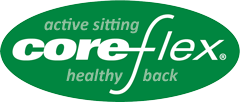Engaging the core when sitting, by Jenny Pynt PhD
Dr. Jenny Pynt is an internationally recognized expert in the field of sitting ergonomics. She has published four books, and numerous journal and lay articles on sitting, chair design, and lower back pain. You may see Dr. Pynt's resume here.
Summary:
Some chair mechanisms offer the potential to exercise the abdominal and spinal muscles, commonly known as the core muscles. However, optimal use of such chairs, particularly if you have had an acute episode of low back pain, may require retraining your deep abdominal muscles in order to re-open the pathway between the brain and the deep abdominal/spinal muscle. This article explains why and how you retrain the core muscles.
 What and where are the core muscles?
What and where are the core muscles?
The core muscles are a series of muscles that form an inbuilt corset for the spine. They are divided into a deep and superficial layer.
The deep core muscles may be thought of as forming a canister between the ribs and the pelvis (See Fig. 1). The “roof” of the canister is formed by the diaphragm muscle which assists in breathing. The front of the canister is formed by the transversus abdominus. Just as the name implies this muscle runs transversely across the abdomen from each side of the lower ribs and each side of the pelvis. The floor of the canister is formed by the muscles of the pelvic floor. These are the muscles that surround the urethra, anus and genitals and are responsible for maintaining continence. And the back of the canister is formed by the back muscles, the deep layer of which is called the multifidus. The deep multifidus run between each vertebra. Each individual muscle is responsible for keeping the vertebrae it attaches to in line with the one above and below, so the vertebrae don’t move back and forth on each other. All of the deep muscles work constantly at a very low level. For this they need endurance, not strength.1

Overlying the deep layer of core muscles is the superficial layer. Fig. 2 shows the rectus overlying the transversus muscle). The superficial muscles are the muscles that require strength. For example the rectus abdominus is the muscle that works when doing situps. In the very fit it is often called the “six pack” because it consists of six divisions that run vertically from the ribs to the pelvis. There are also superficial muscles in the back that are responsible for arching or extending the spine that are known as the erector spinae.
Each layer of the core muscles has a different role and therefore requires a different exercise approach. The deep muscles of both the abdomen and the spine need to be able to work for long periods with minimal contraction i.e. they need endurance to keep the spine stable. The superficial muscles of the abdomen and spine need strength to move the spine. In a healthy back the deep and superficial muscles work in harmony to facilitate sitting, standing and exercising without low back pain.2
Why is the term core stability a misnomer?
The term core “stability” is no longer advocated. Too much stability in your spine will make it stiff like concrete with no ability to absorb sudden shocks to which the spine is often subjected. The more important objective is for the deep core muscles to control the spine, with muscles contracting sufficiently, in time and in harmony with each other to allow the spine to move in a controlled and therefore healthy manner.3
How do the deep core muscles protect?
In a healthy spine the deep abdominal muscles work consistently at a very low degree of contraction. They are the worker bees of spinal protection-always droning along at a low level of contraction. Research also demonstrates that in a healthy spine the deep abdominal muscles increase their contraction prior to movement in order to protect the spine and they do this in harmony with their counterparts on the other side of the spine - the deep spinal muscles. However following an episode of acute back pain, communication between the brain and these muscles is interrupted. This means that the spine loses the protection of the deep abdominal and spinal muscles. It is thought that this altered coordination and subsequent loss of harmony between the deep core muscles is a cause of repeated episodes of low back pain.4 If you have had an episode of low back pain, this scenario may apply to you. The loss is retrievable however.
Waking up the deep abdominal muscles
It is possible to revive the connection between the brain and the deep abdominal muscles by waking up the pathway with exercise.5 But there is a specific manner in which these exercises must be practiced. The deep spinal muscles contract before the movement because the brain has already told the muscles to anticipate the movement. But the brain cannot do so if it has forgotten the pathway.6 So you must help the muscle to reconnect with the brain by imagining how the muscle will contract.7 And because the deep muscles work in harmony with the rest of the core muscles you can use the other muscles to help wake up the deep spinal and abdominal muscles.8 Using this idea of imagining where the deep transverse abdominal muscle is and how it works, try the following exercise. Keep in mind that you are after a gentle contraction only:
- In sitting run your thumbs along the top of your pelvis until you come to the point at the front where the pelvic rim drops down. From this point move your thumbs in about 2 finger widths towards the centre. This should place your thumbs where you can palpate the deep transverse abdominal muscle.
- Take a breath in and breathe out as you:
- Imagine your transversus abdominus as a sheet pulling the 2 sides of the pelvis together
- Tighten the muscles around your anus. Hold this gentle contraction and
-
Draw the lower abdomen in towards the spine
- You should feel the deep abdominals tighten under your thumbs.
- Once you can feel this work try to hold a gentle contraction for 5 secs. Try for ten repetitions. Remember this is about endurance not strength i.e. holding a low contraction for a time.
Once you have switched on the communication between the brain and the deep core muscles you are ready to introduce this exercise to your use of the Core-flex chair.
Why is it important to wake up the deep core muscles?
You can still move with a deficient deep core musculature, but you would not be moving in an optimal fashion, and you would be reinforcing bad habits. This is because your superficial core musculature will be getting a workout, but without the protective mechanism of the deeper abdominal muscles. Therefore you’re back is at risk.
To optimise core coordination then, when you first sit in the chair think about switching your deep core muscles on as described in the exercise above. Hold a gentle contraction for 5 seconds and repeat it 10 times. Now that you have checked that your deep core muscles are engaged, start moving the seatpan, while maintaining the gentle contraction. The deep abdominal muscles will continue to anticipate what you want and you’re back on track with optimal spinal use. It is important to engage the deep core muscles to avoid reinforcing incorrect movement patterns.
NB If you cannot switch on your deep abdominal muscles, or you are uncertain that you understand, please see a physiotherapist who is skilled in core muscle training. Many physiotherapists use ultrasound imaging to help you visualise, engage and correctly time the transversus abdominus muscle contraction.
The Core-flex chair and the future of core muscle research
Using the split system of the Core-flex seatpan provides an excellent platform for practicing your core endurance exercise. Try engaging the core as previously described, then begin to use the split seatpan. The alternating movements of the thighs up and down when using the split seatpan system causes the pelvis to tilt from side to side. As you feel confident you understand how to engage the core while moving the legs, try to progress the exercise by minimizing any sideways sway of your trunk. Being able to do this means your trunk is controlled while your legs are moving. Remember, this is not a strengthening exercise. It is an exercise in coordinating the deep and superficial layers of the trunk musculature, in order to provide controlled movement of the spine, while other parts of the body are performing required activities. Think of how the trunk of a tree forms a stable base, while the branches sway.
Copyright of this article remains with the author Dr Jenny Pynt. March 2014
References
1 Hodges PW (2011). Pain and motor control: From the laboratory to rehabilitation. Journal of Electromyography and Kinesiology 21: 220–228
MacDonald DA, Hodges PW, Moseley GL (2006) The lumbar multifidus: Does the evidence support clinical beliefs? Manual Therapy 11: 254–263
2 McGill S (2002) Low back disorders: evidence based prevention and rehabilitation. Champaign, IL: Human Kinetics Publishers, Inc.
3 Hodges P, van den Hoorn W, Dawson A, Cholewicki J ( 2009) Changes in the mechanical properties of the trunk in low back pain may be associated with recurrence. J Biomech 42(1):61–6.
4 Hodges PW, Richardson CA.(1996) Inefficient muscular stabilisation of the lumbar spine associated with low back pain: a motor control evaluation of transversus abdominis. Spine 21:2640–50.
5 Tsao H, Druitt TR, Schollum TM, Hodges PW (2010) Motor training of the lumbar paraspinal muscles induces immediate changes in motor coordination in patients with recurrent low back pain. J Pain, 11(11):1120–8.
Tsao H, Galea MP, Hodges PW (2010) Driving plasticity in the motor cortex in recurrent low back pain. Eur J Pain 14(8):832-9.
6 Tsao H, Danneels LA Hodges PW (2011) ISSLS prize winner: Smudging the motor brain in young adults with recurrent low back pain. Spine 36(21):1721-7
7 Lee D & Lee LJ (2010) The Pelvic Girdle. Elsevier
8 Crow J, Pizzari T, Buttifant D (2011) Muscle onset can be improved by therapeutic exercise: a systematic review. Phys Ther Sport 12(4):199-209.





 What and where are the core muscles?
What and where are the core muscles?